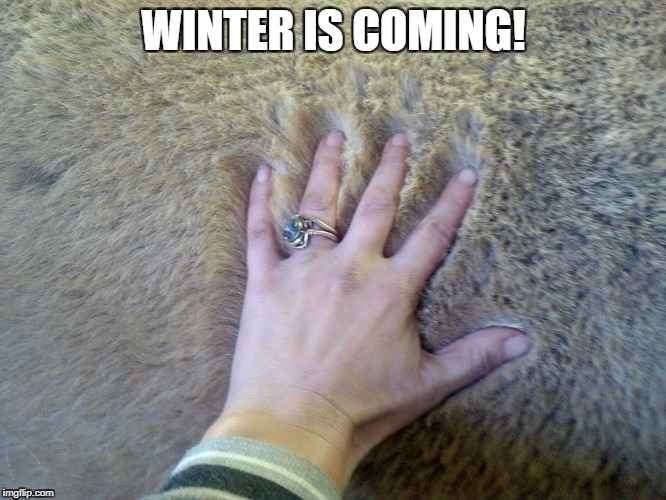
Simply the Science: Blanketing
#ThrowbackThursday.
“Just the facts, ma’am.” Blanketing, for whatever reason, is an annual equestrian debate fraught with emotion. Biz Stamm presents two scientific studies to help clear the air.
As the days grow shorter and the chill of fall creeps into the air, equestrians around the world have one thing on their minds: blankets. With this time of year comes the obligatory and puzzlingly contentious forum threads on whether or not one should blanket their horse. I highly recommend reading these threads — not because they offer insightful information, but because they can be incredibly entertaining.
In addition to these threads you may also find the famously viral posts about studies done at any number of universities that claim blanketing your horse is completely unnecessary and may even be bad for them. Fake news! The truth is there is no evidence that the studies in those viral posts ever even occurred. The most popular of these posts cites a study conducted at Colorado State University College of Veterinary Medicine, but officials at CSU have no knowledge of any such research.
All the talk of those fake studies got me thinking, what research actually has been done on blanketing, and what can we deduce from the results? Well, after scouring Web of Science, Google Scholar, Ebscohost and various other academic databases, I was able to come up with a grand total of two studies. I was shocked. I honestly thought there would be tons of them, but alas, there were two. Here’s what I found.
The first study, entitled Horses can learn to use symbols to communicate their preferences (Mejdell et al. 2016), examined horses’ abilities to choose blanket options under different weather conditions. Three symbols were used to communicate “blanket on,” “blanket off,” and “no change.” Positive reinforcement training was used to teach horses to approach, touch and differentiate between the three symbols. After training was complete, horses were given the opportunity to approach these symbols in a “free choice” situation.
The results showed the horse’s choices were far from random. When the weather was warm horses chose to go without blankets, and when the weather was cold and wet horses opted to have blankets put on (p<0.005). On top of being a fascinating study on the ability of equines to understand the resulting outcomes of different choices, the results also indicate that horses probably don’t hate us for bundling them up in their turnout rug when the weather is less than ideal.

Helix has learned the art of of pointing as well. Here he points at the word “please” to indicate “give me a cookie immediately hooman!…please.” Photo by Biz Stamm.
The second study, Influence of blanketing and season on vitamin D and parathyroid hormone, calcium, phosphorus, and magnesium concentrations in horses in New Zealand (Azarpeykan et al. 2015), examined the concentrations of major nutrients in the blood serum of both blanketed and unblanketed horses over the course of a year. While there was no significant difference between blanketed and unblanketed groups, the study suggested that horses may manufacture inadequate levels of vitamin D regardless of their blanketing status making dietary supplementation necessary. They recommend more research to further investigate this finding.
Now that you’re aware of the current science on blanketing, you can make a rational decision about whether or not you want blanket your horse (see here for the SmartPak blanketing guide if you need help making this decision). If you do in fact choose to blanket your horse because, let’s say, you clip for performance purposes, or your horse doesn’t grow much of a winter coat, here are a few common sense things to keep in mind.
First off, don’t put a blanket on your horse if he looks like this.
Before putting a blanket on, be sure your horse is clean and dry. Mud under a blanket can be extremely uncomfortable and lead to painful rubs. A good currying goes a long way.
Next, be sure the blanket fits. Blankets that are too large can lead to dangerous entanglement situations, and blankets that are too small can lead to rubs. Here is a useful video explaining how to properly fit your horse with the correct blanket size.
Be sure to check under the blanket regularly. Don’t just slap a blanket on your horse and leave it on for weeks at a time. Remove the blanket frequently for grooming and to check for signs of possible injury or illness. It is also important to monitor your horse’s overall body condition in the colder months which is incredibly difficult to do through layers of canvas and batting. The whole “out of sight, out of mind,” mentality is not productive when blanketing your horse, so don’t fall into that trap.
Lastly, use your head. If your horse is shivering, maybe put a blanket on him. If he’s sweating, maybe consider a lighter blanket, or removing the blanket all together. This whole blanketing thing really isn’t that difficult. So long as you’re attentive to your horse’s needs, you can expect smooth sailing this upcoming blanketing season.
Go riding!








Leave a Comment